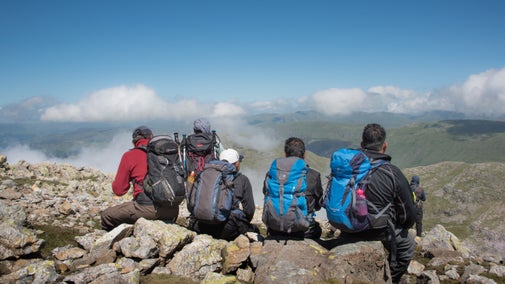
Discover more at Wasdale
Find out how to get to Wasdale, where to park, the things to see and do and more.

Discover the diverse history of the valley of Wasdale, one of the most significant sites in the National Trust’s Lake District portfolio, from Mesolithic times up to the present day. Find out how it played an early role in the pursuit of rock climbing, and how it was the site of a successful 1970s campaign by the Trust and partner organisations to overturn a nuclear power project.
Wasdale, in the far western Lake District, is a valley of extremes: England’s highest mountain, Scafell Pike, looking down on England’s deepest lake, Wastwater.
But it’s also a place of contrasts. The high, jagged fells that belong to the Borrowdale Volcanic Group abruptly give way, as the valley runs southwest, to a gentle, wooded, pastoral landscape including large country houses, gardens and parkland. The scene opens out further as the valley runs into the estuary where the rivers Irt and Mite meet the sea.
There’s a brooding drama to Wasdale, with the imposing bulk of Great Gable, Kirk Fell and Yewbarrow at its head, and the spectacular sight of The Screes plunging into the glacial U-shaped valley lake.
The earliest surviving traces of human activity in Wasdale date back to Mesolithic times. Neolithic stone axe workings have been found high up on Scafell Pike and evidence of Bronze Age settlement exists on the valley bottom.

Early medieval and Norse finds have been made elsewhere in the valley. By the early 1300s there were four recorded vaccaries, or commercial cattle farms, in Wasdale and by 1547, there were 19 farms listed in rent records.
Today, Wasdale is one the Lake District’s key valleys for rearing the hardy Herdwick breed of sheep. The annual Wasdale Show and Shepherds’ Meet is one of the main events of the Herdwick farmers’ year. Other than charcoal production in the local woods and a small amount of mining on Irton Fell, farming was, and still is, the main economic activity here.
Cultural tourism to Wasdale was limited in the 18th and 19th centuries because of its far westerly location, but the more adventurous were starting to come here for the sport of rock climbing. This began to develop in the late 19th and early 20th centuries, encouraged by key figures such as Walter Parry Haskett Smith and the Abraham brothers of Keswick.
Haskett Smith’s ascent of the famous Napes Needle on Great Gable in 1886 was a landmark in the popularity of rock climbing in the Lake District. The Wasdale Head Inn at the far end of the valley became a thriving centre for walkers and climbers, and still is today.

Wasdale is one of the most significant valleys in the National Trust’s Lake District portfolio and it now owns and protects a number of farms and some 6,677 hectares of land. The Fell and Rock Climbing Club also donated 3,000 acres of land to the Trust, including the iconic fell of Great Gable as a memorial to the fallen of the First World War.
In the late 1970s, the National Trust, Friends of the Lake District, the Youth Hostel Association and other local groups and individuals came together and successfully managed to overturn a proposal by British Nuclear Fuels to increase the abstraction of water from Wastwater.
Despite its more remote position, Wasdale is perhaps one of the best known and well-loved valleys in the Lake District thanks to its spectacular landscape of lake, screes and high mountains which, fittingly, form the basis of the Lake District National Park official logo.

Find out how to get to Wasdale, where to park, the things to see and do and more.

Explore Wasdale to discover England’s highest mountain peak and its deepest lake, and everything else that this area of the Lake District has to offer.

Discover more about our restoration projects at Wasdale and Scafell Pike and how hydro power in the West Lakes is making a difference to our fossil fuel usage.

Find out more about how to prepare for climbing Scafell Pike, England’s highest mountain peak, and follow safety procedures.

Learn about people from the past, discover remarkable works of art and brush up on your knowledge of architecture and gardens.